#728 APOD is Two Years Old Today June 16, 1997
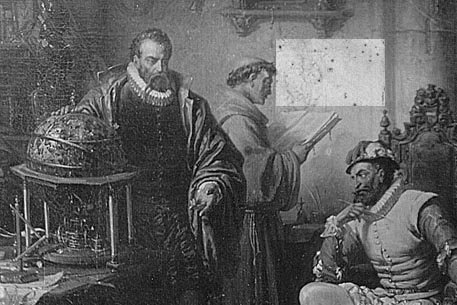
“The first Astronomy Picture of the Day (APOD) appeared two years ago today. Pictured above is a scene surrounding the creation of an early APOD, depicting the famous astronomer Tycho Brahe demonstrating a celestial globe to Emperor Rudolph II. The image of a possible optical counterpart to a gamma-ray burst appears on the back wall. In Tycho's day, humanity discovered the nature of the Earth and the geometry of the Solar System. The times we live in are even more fascinating as we explore the nature of our Solar System and the geometry of our whole universe. APOD continues to chronicle these events by finding, presenting ,and annotating the most important astronomical pictures of our time, and cataloging them in an indexed and searchable archive. Link to APOD and discover the cosmos! With over five million pages served, we thank NASA, Michigan Tech, USRA, and most of all our readers, for their continued support."
Copyright: Public domain
#729 Arp 220: Spirals in Collision June 17, 1997
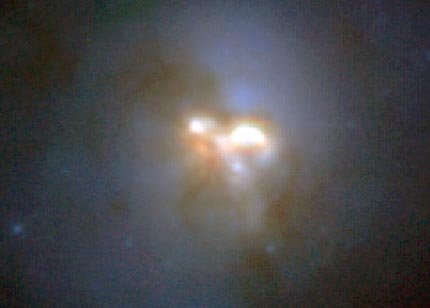
“Arp 220 is the brightest object in the local universe. But why does it shine so brightly? Arp 220 was cataloged as a peculiar galaxy in the 1960s. In the late 1980s, it was discovered to be an ultraluminous infrared galaxy and headed a list compiled from observations with the now-defunct IRAS satellite. New observations with the Hubble Space Telescope are quite revealing. Photos by NICMOS in the infrared taken in April and released just last week now better resolve the two colliding spiral galaxies at the center of Arp 220. A result of this spiral collision are fantastic knots of new star formation visible as the bright spots on the above photograph. Below the "half-moon" shaped knot on the right is a massive disk of dust possibly hiding a dying spiral's central black hole. The bright knot to the left is the center of the other broken spiral galaxy. The galaxy cores are about 1200 light years apart and are orbiting each other."
Copyright: Public domain
#730 Asteroid 3753: Earth's Curious Companion June 18, 1997
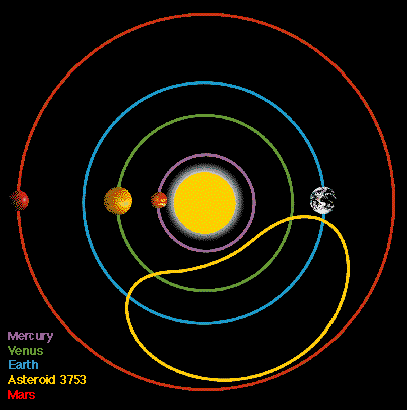
“rth is not alone. It orbits the Sun with a small companion: Asteroid 3753. First discovered in 1986 and designated 1986 OT, this five kilometer rock was recently found to orbit the Sun while executing a strange dance with the Earth. A portion of the asteroid's complex orbit is shown above. As the Earth orbits once, Asteroid 3753 follows the yellow line - while also orbiting the Sun. Each time around, however, the yellow kidney-bean traced by Asteroid 3753 shifts slightly - eventually going from trailing the Earth to leading the Earth. Every 385 years the cycle repeats. Because the plane of 3753's orbit is tilted when compared to the Earth's orbit, the two will never collide. In autumn 1997, Asteroid 3753 will pass below the Earth's South Pole at about 100 times the distance to the Moon. It will, however, be very faint - about 15th magnitude - 10,000 times fainter than the dimmest star without a telescope. Suggestions are being taken for a good name for this asteroid."
Copyright: York U.
#731 HH1/HH2: Star Jets June 19, 1997
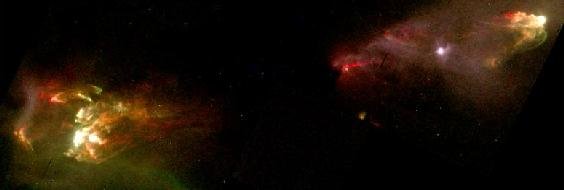
“A cloud of interstellar gas and dust collapses and a star is born. At its core temperatures rise, a nuclear furnace ignites, and a rotating dusty disk forms surrounding the newborn star. According to current understanding, as material continues to fall onto the disk it is heated and blasted back out along the disk's axis of rotation, forming a pair of high speed jets. This Hubble Space Telescope image shows two nebulosities at the ends of opposing jets from a young star. The bright blobs at either end are where the jet material has slammed into interstellar gas. Tip to tip, the distance is about one light-year. Located near the Orion Nebula, these nebulosities have catalog designations HH1 and HH2 for their discoverers astronomers George Herbig and Guillermo Haro. The nascent star which produced the jets is in the middle, hidden by a cloud of obscuring dust. Yet the structures and details visible in the star jets offer clues to events which also occured in our own Solar System - when the Sun was formed from a collapsing interstellar cloud 4.5 billion years ago."
Copyright: Public domain
#732 NGC1850: Star Cluster in the LMC June 20, 1997
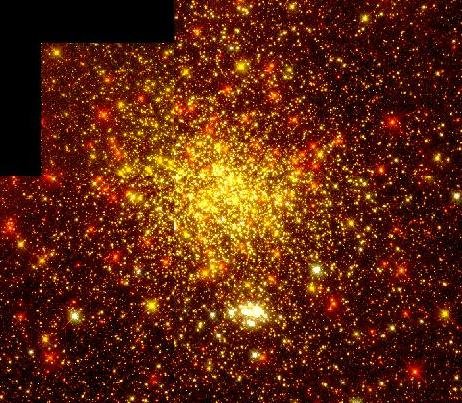
“NGC1850 is a large cluster of stars located a mere 166,000 light-years from Earth in our neighboring galaxy the Large Magellanic Cloud (LMC). The colors in this beautiful Hubble Space Telescope composite image of the cluster reveal different populations of stars. Yellowish stars are the main cluster stars, sun-like main sequence hydrogen burners about 50 million years old. The white stars are massive, hotter, and younger, about 4 million years old. Radiating strongly in ultraviolet light, they represent a loose cluster themselves, perhaps within 200 light-years of the main cluster. Massive stars which formed in the older main cluster have long since disappeared, ending their lives in spectacular supernova explosions. Did expanding debris from these supernovae trigger the formation of the nearby younger cluster? Probably so. In any event, a few million years from now a similar fate awaits the massive stars of the younger cluster - burning brightly but briefly before they explode sending new clouds of stellar debris into space."
Copyright: Public domain
#733 The Pipe Dark Nebula June 21, 1997
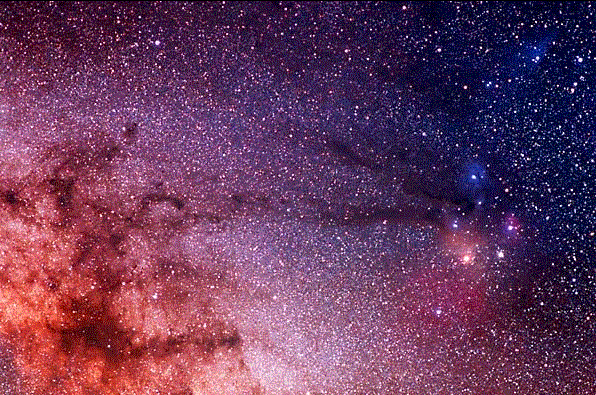
“The dark nebula predominant at the lower left of the above photograph is known as the Pipe Nebula. The dark clouds, suggestively shaped like smoke rising from a pipe, are caused by absorption of background starlight by dust. These dust clouds can be traced all the way to the Rho Ophiuchi nebular clouds on the right. The brightest star in the field is Antares. Many types of nebula are highlighted here: the red are emission nebula, the blue are reflection nebula, and the dark are absorption nebula. This picture has been digitally enhanced."
Copyright: Jerry Lodriguss
#734 Distant Galaxies June 22, 1997
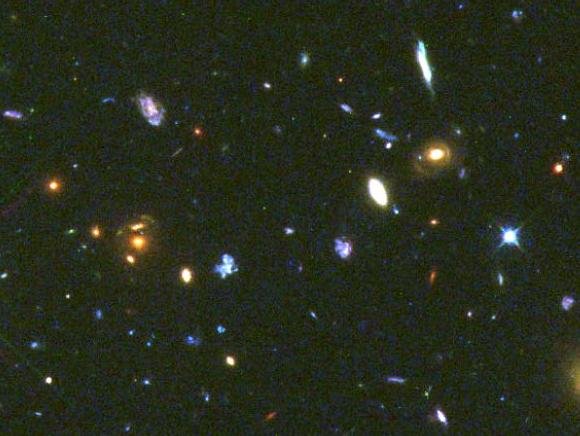
“This Hubble Space Telescope image of a group of faint galaxies "far, far away" is a snap shot of the Universe when it was young. The bluish, irregularly shaped galaxies revealed in the image are up to eight billion light years away and seem to have commonly undergone galaxy collisions and bursts of star formation. Studying these objects is difficult because they are so faint, however they may provide clues to how our own Milky Way Galaxy formed."
Copyright: Public domain
#735 Eruption on Io June 23, 1997
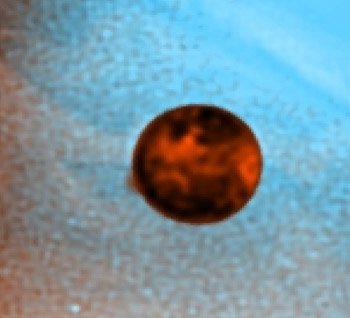
“There it goes again. Gas and rock were catapulted hundreds of kilometers into space as Jupiter's most volatile moon, Io, showed yet another impressive volcanic display in this just-released photograph by the Hubble Space Telescope. This time the culprit was Pele, a volcano thought previously inactive since photographed by the passing Voyager 1 spacecraft in 1979. The explosion is visible on Io's lower left in this false-color photograph, taken in July 1996. Io's thin atmosphere and low gravity allow volcanic plumes to rise higher than they would on Earth."
Copyright: Public domain
#736 Antares June 24, 1997
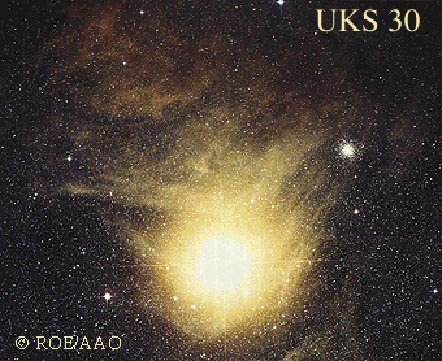
“Antares is a huge star. In a class called red supergiant, Antares is about 700 times the size of our own Sun, 15 times more massive, and 10,000 times brighter. Antares is the brightest star in the constellation of Scorpius and one of the brighter stars in all the night sky. Antares is surrounded by a nebula of gas which it has itself expelled. Radiation from Antares' blue stellar companion helps cause the nebular gas to glow, as photographed above. Antares is located about 500 light years away."
Copyright: AAOAATBUKS Telescope
#737 A GRB Host? June 25, 1997
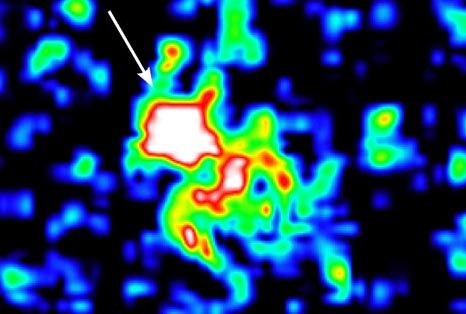
“Where do gamma-ray bursts (GRBs) originate? The most powerful explosions in the universe have recently been located with record accuracy. But do GRBs occur in galaxies or out alone in deep space? This picture taken with the Hubble Space Telescope of the field surrounding GRB 970228 might provide a clue. It appears to show an extended structure to the lower right of the GRB, which is identified with an arrow. Many astronomers speculate that this extended structure is a distant galaxy, as its colors and subsequent steady emission indicate. Other astronomers worry that the extended emission is variable and so cannot be a galaxy. Astronomers hoping for more cases to study were rewarded just last Monday with a new, well-located event: GRB 970616. The location of this burst was determined by an unprecedented collaboration involving the tandem use of NASA satellites Compton, Ulysses and Rossi."
Copyright: Public domain
Upvote! Resteem! Comment! As you like it! Thank you for attention!
i love seeing these pictures :Dnew follower here :)
Downvoting a post can decrease pending rewards and make it less visible. Common reasons:
Submit
I'm glad you like it! I also love cosmos things)
Downvoting a post can decrease pending rewards and make it less visible. Common reasons:
Submit